Hello meanie,
I asked same question in post 651 which fab replied in post 657. Basically, you need to connect both PGND and GND to PSU ground.
Thanks
Balaji
I asked same question in post 651 which fab replied in post 657. Basically, you need to connect both PGND and GND to PSU ground.
Thanks
Balaji
The above speaker output voltage are with respect to PGND.
However, if i measure speaker output terminal with respect to GND tab, I can achieve less than 5mV readings.
Briefly touch my finger at the input terminal, the multimeter register some AC voltage swings. I think my amp is working, but the PGND and GND tabs confuses me now.
Just sharing...
While awaiting for my bias resistors for the other channel, i decide to replace my working F6 right channel and replace with one USSA5 channel.
Initial sound test reveal gain of USSA5 is a tad higher, after few hours of swapping L&R interconnect cable from preamp, i found out the USSA5 is more detail, improved clarity, and slightly better high. This is without any breaking in period yet.
Currently with 1.05A bias, heat sink is about 55 degC, input coupling cap 4.7uF was not used.
Think i will fall in love this USSA5 amp soon. There is nothing wrong with F6, just that its abit mellow with my cloned M7...
Initial sound test reveal gain of USSA5 is a tad higher, after few hours of swapping L&R interconnect cable from preamp, i found out the USSA5 is more detail, improved clarity, and slightly better high. This is without any breaking in period yet.
Currently with 1.05A bias, heat sink is about 55 degC, input coupling cap 4.7uF was not used.
Think i will fall in love this USSA5 amp soon. There is nothing wrong with F6, just that its abit mellow with my cloned M7...
Hi meanie
So this is a new hybrid amp😉😛
I just notice that the thermistors leads seem that they could be shorten a bit.
Continue the good work🙂
Fab
So this is a new hybrid amp😉😛
I just notice that the thermistors leads seem that they could be shorten a bit.
Continue the good work🙂
Fab
Thanks Fab, will shorten the lead after final tune up.
One question, if i can maintain my heatsink temp to below 60 degC, is it safe to run the amp at higher bias ? Something like 1.25A (60+ mV) ?
One question, if i can maintain my heatsink temp to below 60 degC, is it safe to run the amp at higher bias ? Something like 1.25A (60+ mV) ?
Meanie, you can put a higher bias but I do not recommend to have heatsink at higher temp than 55C because it may be unsafe for small children....
I would suggest you listen in stereo (both USSA5 channels) before considering to increase bias anyway. I also strongly recommend a thermal cutout installed on the heatsinks as indicated in the manual. At the end, you want to avoid any flaw to destroy your gear...
Fab
I would suggest you listen in stereo (both USSA5 channels) before considering to increase bias anyway. I also strongly recommend a thermal cutout installed on the heatsinks as indicated in the manual. At the end, you want to avoid any flaw to destroy your gear...
Fab
Last edited:
The thermistors do not require attachments to heatsink. The tension of the thermistor leads is sufficient and they do not necessarily need to touch the heatsink but they should be very close too at least.
Fab
Fab
Ground Connections
Hi Folks,
at the moment I am a little bit to busy and could not find as many free time as I want. 😱
Sadly not everything works as wanted, I ordered my LDR attenuator for my USSPA six weeks ago and since last week he is in Germany, but the customer service must have a lot of fun with it, they can not part with it! 😀😡
So I have to wait, but I am so curious! Out of impatience I still have put the USSPA on a sheet of wood, together with two UltraBIBs and a Alps attenuator.
Even in this very diy situation, with no HiFi or boutique cables in the signal way and with no big break or burn in it sounds better (with the USSA 5) then my slightly improved Musically Fidelity M6si. More on this when it is complete.
But out of the diy build I have had hum in the system and that was the reason why I gambled around with the ground. To my big surprise it does not only influence the hum, it also influenced the sound in my system. As example when I pull down the signal in ground directly to the star ground it sounds more crispy, cleaner and / or with more heights ( sometimes interesting and good, sometimes disturbing). On the other way the connector for signal in on the USSPA and the USSA with a small resistor before the ground connector sounds warmer and more relaxed. I find this behavior very interesting and asks myself why FAB build it this way (with the resistor before ground ) and what makes the difference (why)?
So my big question is, have you played with the ground connection too and what are your findings, or what do you prefer (why)?
I am awaiting all your answers!!!
Hopefully I could consider your findings before the final build. 😉
Good luck and lots of fun with your builds
André
Hi Folks,
at the moment I am a little bit to busy and could not find as many free time as I want. 😱
Sadly not everything works as wanted, I ordered my LDR attenuator for my USSPA six weeks ago and since last week he is in Germany, but the customer service must have a lot of fun with it, they can not part with it! 😀😡
So I have to wait, but I am so curious! Out of impatience I still have put the USSPA on a sheet of wood, together with two UltraBIBs and a Alps attenuator.
Even in this very diy situation, with no HiFi or boutique cables in the signal way and with no big break or burn in it sounds better (with the USSA 5) then my slightly improved Musically Fidelity M6si. More on this when it is complete.
But out of the diy build I have had hum in the system and that was the reason why I gambled around with the ground. To my big surprise it does not only influence the hum, it also influenced the sound in my system. As example when I pull down the signal in ground directly to the star ground it sounds more crispy, cleaner and / or with more heights ( sometimes interesting and good, sometimes disturbing). On the other way the connector for signal in on the USSPA and the USSA with a small resistor before the ground connector sounds warmer and more relaxed. I find this behavior very interesting and asks myself why FAB build it this way (with the resistor before ground ) and what makes the difference (why)?
So my big question is, have you played with the ground connection too and what are your findings, or what do you prefer (why)?
I am awaiting all your answers!!!
Hopefully I could consider your findings before the final build. 😉
Good luck and lots of fun with your builds
André
Are you using the 2 UltraBibs as the main power supply for the amp, and if so, what current are they set to and what current & voltage on each channel of the amp?
Are you using the 2 UltraBibs as the main power supply for the amp, and if so, what current are they set to and what current & voltage on each channel of the amp?
Hi jameshillj,
Yes I am using the UltraBIBs as the main power supply.
I have used both combinations, “one” UltraBIB (+ and -) with one transformer and “two” UltraBIBs with two transformers (for dual mono). In my test system I find that the differences in the sound are not so big as with the changes I made with the different ground points (as described). After looking at a few pictures from power supplies in this forum, I am unsure if everyone puts the power supplies 0V to the ground point. This makes a difference too.
In the final system I want to use the dual mono configuration (to be on the safe side). 😉
But back to your question, I set the UltraBIBs to 15V with 200mA (3Ohm) current ( around 50mA for the Usspa and the rest as secure/headroom as described from Salas). The Usspa itself is set to a current of 70mA (taken from the schematic) without getting warm (the UltraBIBs are producing more heat).
Hope this will help you.
If someone has thoughts or suggestions please let me know.
André
Ah, this is the preamp - sorry, thought it was the power amp and wondered how you got enough power thru the Bibs - silly me. Thanks for your reply
Hello andré
The problem is certainly because of the wiring and it would be interesting to have a picture of your set on the table.
For information in all my audio editing I never connect the GND to the ground and only the wire provided for this grounding is connected to the chassis, all signal connectors are isolated from the chassis.
Olivier
The problem is certainly because of the wiring and it would be interesting to have a picture of your set on the table.
For information in all my audio editing I never connect the GND to the ground and only the wire provided for this grounding is connected to the chassis, all signal connectors are isolated from the chassis.
Olivier
Hi, apologies if this is a silly question. There are three pcb holes for signal input. I would like to Confirm the following:
Furthest away (from the pcb edge) is ground (gc)
The other two pins are shorted and are both signal input.
Tia
Furthest away (from the pcb edge) is ground (gc)
The other two pins are shorted and are both signal input.
Tia
thank you.Hello Tia
You can use a two-pin or three-pin connector and only the pin marked GC is GND.
Tia (alias surfatwork) 🙂
Hello andré
The problem is certainly because of the wiring and it would be interesting to have a picture of your set on the table.
For information in all my audio editing I never connect the GND to the ground and only the wire provided for this grounding is connected to the chassis, all signal connectors are isolated from the chassis.
Olivier
Hi Olivier,
Thanks for your response. You said that you never connect the GND to the ground, does it mean that you never have tried it or that you only decided against it after hearing?
In mostly every schematic I found a ground symbol on the 0V line, even in your power supply for the USSA.
Do I make a mistake? Do I misunderstood the American symbols?
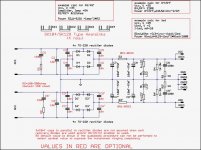
Papa use it too!
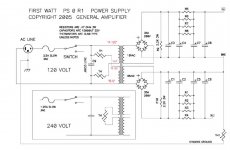
Normal Schematics:
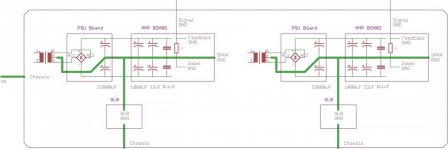
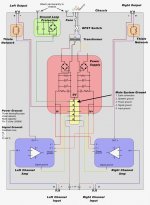
The differences for the USSPA are you have not used or tried the ground connection for the power supply (different sound).
Fab put the output ground (speaker ground) to ground on his PCB (the difference /as expected)
(On the USSA-5 we connect it as "normal" to the power supply)
For both the USSA-5 and the USSPA Fab connects the Input ground over a small resistor to the ground ("not normal") this makes a difference too when you connect it directly to the star ground.
My point is why he made it this way and specially why this small resistor changes the sound.
Is this only my finding or have other find this too?
For your eyes only (😉)
Picture from my test setup:
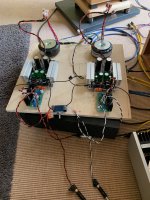
André
- Home
- Amplifiers
- Solid State
- USSA-5 Build with Review